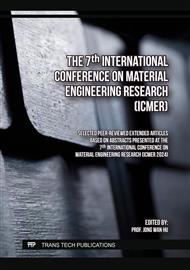[1]
Abas, N, A Kalair, and N Khan. 2017. 'Review of Fossil Fuels and Future Energy Technologies'. Futures 69 p.31–49
DOI: 10.1016/j.futures.2015.03.003
Google Scholar
[2]
Aghaei, Mohammadreza, Samira Damanafshan, Mohammad Abyari, and Mohammad Noor Imamzai. 2014. 'An Overview of Solar Cells Materials Classification'. National Graduate Conference p.18–19 www.ijert.org.
Google Scholar
[3]
Ali,Feroz, and Faruk Hossain. 2017. 'Influence of Front and Back Contacts on Photovoltaic Performances of P-n Homojunction Si Solar Cell : Considering an Electron-Blocking Layer' 2017.
DOI: 10.1155/2017/7415851
Google Scholar
[4]
Attari, Kamal, Lahcen Amhaimar, Ali El Yaakoubi, Adel Asselman, and Mounir Bassou. 2017. 'The Design and Optimization of GaAs Single Solar Cells Using the Genetic Algorithm and SilvacoATLAS'. International Journa lof Photoenergy 2017. https://doi.org/
DOI: 10.1155/2017/8269358
Google Scholar
[5]
Almosni, Samy, Amaury Delamarre, Zacharie Jehl, Daniel Suchet, Ludmila Cojocaru, Maxime Giteau, Benoit Behaghel, et al. 2018. 'Material Challenges for Solar Cells in the Twenty-First Century: Directions in Emerging Technologies'. Science and Technology of Advanced Materials 19 (1): 336–69
DOI: 10.1080/14686996.2018.1433439
Google Scholar
[6]
Attari, Kamal, Lahcen Amhaimar, Ali El Yaakoubi, Adel Asselman, and Mounir Bassou. 2017. 'The Design and Optimization of GaAs Single Solar Cells Using the Genetic Algorithm and SilvacoATLAS'. International Journal of Photoenergy 2017. https://doi.org/
DOI: 10.1155/2017/8269358
Google Scholar
[7]
Belfar. A, Amiri. Aït-Kaci.H. 2015. 'Optimization of Band Gap and Thickness for the Development of Efficient N-i-P+ Solar Cell' 7 (2): p.1–7 http//essuir.sumdu.edu.ua/handle/ 123456789/41389
Google Scholar
[8]
Böer, K.W., 2013. The CdS/CdTe Solar Cell. In Handbook of the Physics of Thin-Film Solar Cells (pp.649-658). Springer, Berlin, Heidelberg
DOI: 10.1007/978-3-642-36748-9
Google Scholar
[9]
Cotal, Hector, Chris Fetzer, Joseph Boisvert, Geoffrey Kinsey, Richard King, Peter Hebert, Hojun Yoon, and Nasser Karam. 2009. 'III-V Multijunction Solar Cells for Concentrating Photovoltaics'. Energy and Environmental Science 2 (2):174–92 per can be found in the link: http://engineeringjournals.stmjournals.in/index.php/JoAEST/article/view/3332.
DOI: 10.1039/b809257e
Google Scholar
[10]
Chandrasiri, M.D.S.D., Attyagalle, M. and Wickramasinghe, H., 2017. Temperature Effect on Solar Photovoltaic Power Generation.
DOI: 10.14293/S2199-1006.1.SOR-.PPOSK8U.v1
Google Scholar
[11]
Mahfoud, Abderrezak, Mohamed Fathi, Abderrahmane Belghachi, and Farid Djahli. 2016. 'Numerical Modeling of GaInP/GaAs Monolithic Tandem Solar Cells'. AIP Conference Proceedings 1758 (July 2016).
DOI: 10.1063/1.4959390
Google Scholar
[12]
Mebarkia, C., Dib, D., Zerfaoui, H. and Belghit, R., 2016. The energy efficiency of a photovoltaic cell-based thin films CZTS by SCAPS. Journal of Fundamental and Applied Sciences, 8(2), pp.363-371
DOI: 10.4314/jfas.v8i2.13
Google Scholar
[13]
Nic Daeid, N., 2011. 2011 Nanoelectronic Devices for Defense & Security (NANO-DDS) Conference Held in Brooklyn, New York on August 29-September 1, 2011. Technical Program and Abstract Digest https://digitalcommons.library.umaine.edu/orsp_reports/323.
Google Scholar
[14]
Mostefaoui, M., H. Mazari, S. Khelifi, A. Bouraiou, and R. Dabou. 2015. 'Simulation of High-Efficiency CIGS Solar Cells with SCAPS-1D Software'. Energy Procedia 736–44. 2015.07.809.
DOI: 10.1016/j.egypro.2015.07.809
Google Scholar
[15]
Paul, Sanjoy, Sachit Grover, Ingrid L. Repins, Brian M. Keyes, Miguel A. Contreras, Kannan Ramanathan, Rommel Noufi, Zhibo Zhao, Feng Liao, and Jian V. Li. 2018. 'Analysis of Back-Contact Interface Recombination in Thin-Film Solar Cells'. IEEE Journal of Photovoltaics 8 (3): 871–78.
DOI: 10.1109/JPHOTOV.2018.2819664
Google Scholar
[16]
Oyedele, Sampson Oladapo, and Boko Aka. 2017. 'Numerical Simulation of Varied Buffer Layer of Solar Cells Based on Cigs'. Modeling and Numerical Simulation of Material Science 07 (03): 33–45.2017.73003 http://creativecommons.org/licenses/by/4.0/.
DOI: 10.4236/mnsms.2017.73003
Google Scholar
[17]
Harame, D.L., Comfort, J.H., Cressler, J.D., Crabbe, E., Sun, J.C., Meyerson, B.S. and Tice, T., 1995. Si/SiGe epitaxial-base transistors. I. Materials, physics, and circuits. IEEE Transactions on Electron Devices, 42(3), pp.455-468
DOI: 10.1109/16.368039
Google Scholar
[18]
Tanabe, Katsuaki. 2009. 'A Review of Ultrahigh Efficiency III-V Semiconductor Compound Solar Cells: Multijunction Tandem, Lower Dimensional, Photonic Up/Down Conversion and Plasmonic Nanometallic Structures', 504–30.
DOI: 10.3390/en20300504
Google Scholar
[19]
Gul, M., Kotak, Y. and Muneer, T., 2016. Review the recent trends in solar photovoltaic technology. Energy Exploration& 34(4), pp.485-526.
DOI: 10.1177/0144598716650552
Google Scholar
[20]
Singh, J, Aoki, T., Shimabara, K., & Ruda, H. (2007). Proceedings of the international conference on optical and optoelectronic properties of materials and applications (ICOOPMA 2006) Darwin, Australia, 16–21 July 2006. Journal of Materials Science: Materials in Electronics, 18, 1-1.p.157
DOI: 10.1007/s10854-007-9154-3
Google Scholar
[21]
Olusola, O.I.O., Madugu, M.L.and Dharmadasa, I.M., 2015. Growth of n-and p-type ZnTe semiconductors by intrinsic doping. Materials Research Innovations, 19(7), pp.497-502.
DOI: 10.1080/14328917.2015.1105570
Google Scholar
[22]
Kole, G.K., Vivekananda, K.V., Kumar, M., Ganguly, R., Dey, S. and Jain, V.K., 2015. Hemilabile silver (I) complexes containing pyridyl chalco genolate (S, Se) ligands and their utility as molecular precursors for silver chalcogenides. CrystEngComm, 17(23), pp.4367-4376. Doi https//doi.org/.
DOI: 10.1039/C5CE00626K
Google Scholar
[23]
Kazici, Mehmet, Sinem Bozar, Anil Gürşen, Fatih Ongül, Adem Karsli, Niyazi S. Sariciftci, and Serap Günes. 2018.'Solar Cells.Comprehensive Energy Systems 4–5 (7): 637–58.
DOI: 10.1002/crat.202200138
Google Scholar
[24]
King, R. R., D. C. Law, K. M. Edmondson, C. M. Fetzer, G. S. Kinsey, H. Yoon, R. A. Sherif, and N. H. Karam. 2007. '40% Efficient Metamorphic GaInPGaInAsGe Multijunction Solar Cells'. Applied Physics Letters 90 (18);.
DOI: 10.1063/1.2734507
Google Scholar
[25]
Korun, M., and T. S. Navruz. 2016. 'Comparison of Ge, InGaAs p-n Junction Solar Cell'. Journal of Physics: Conference Series 707 (1.
DOI: 10.1088/1742-6596/707/1/012035
Google Scholar
[26]
Kumar, Atul. 2021. 'Theoretical Analysis of CZTS / CZTSSe Tandem Solar Cell'. Optical and Quantum Electronics 53 (9): 1–8.
DOI: 10.1007/s11082-021-03183-5
Google Scholar
[27]
Leijtens, Tomas, Kevin A. Bush, Rohit Prasanna, and Michael D. McGehee. "Opportunities and challenges for tandem solar cells using metal halide perovskite semiconductors." Nature Energy 3, no. 10 (2018): 828-838.
DOI: 10.1038/s41560-018-0190-4
Google Scholar
[28]
Liu, Shi, Jacob Becker, Stuart Farrell, Weiquan Yang, and Yong-hang Zhang. 2013. 'SiO 2 / ZnSe Anti-Reflection Coating for Solar Cells', no. March 2016 DOI:10.1109/PVSC.2013. 6744889.
DOI: 10.1109/pvsc.2013.6744889
Google Scholar



